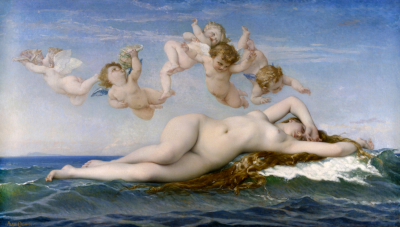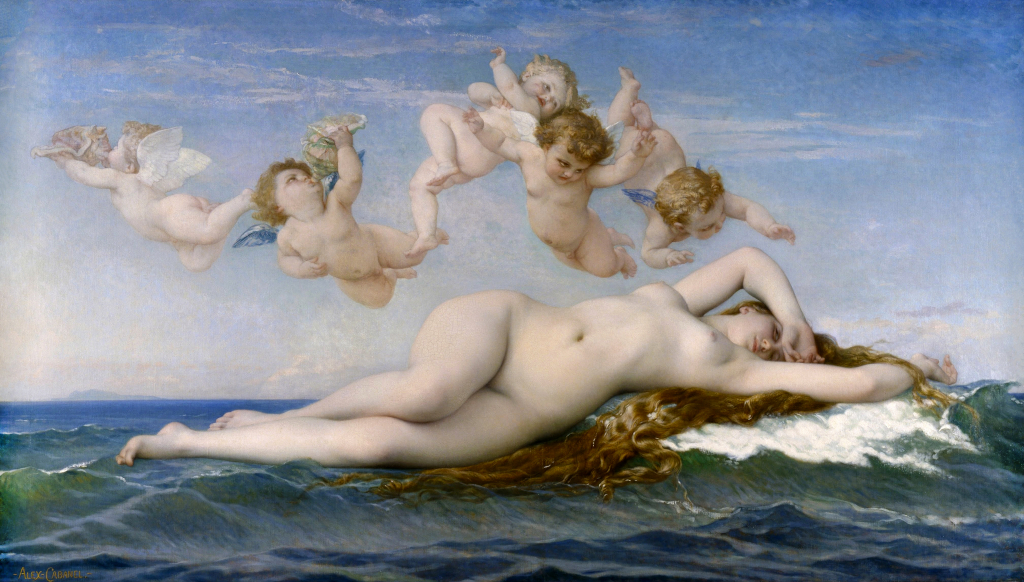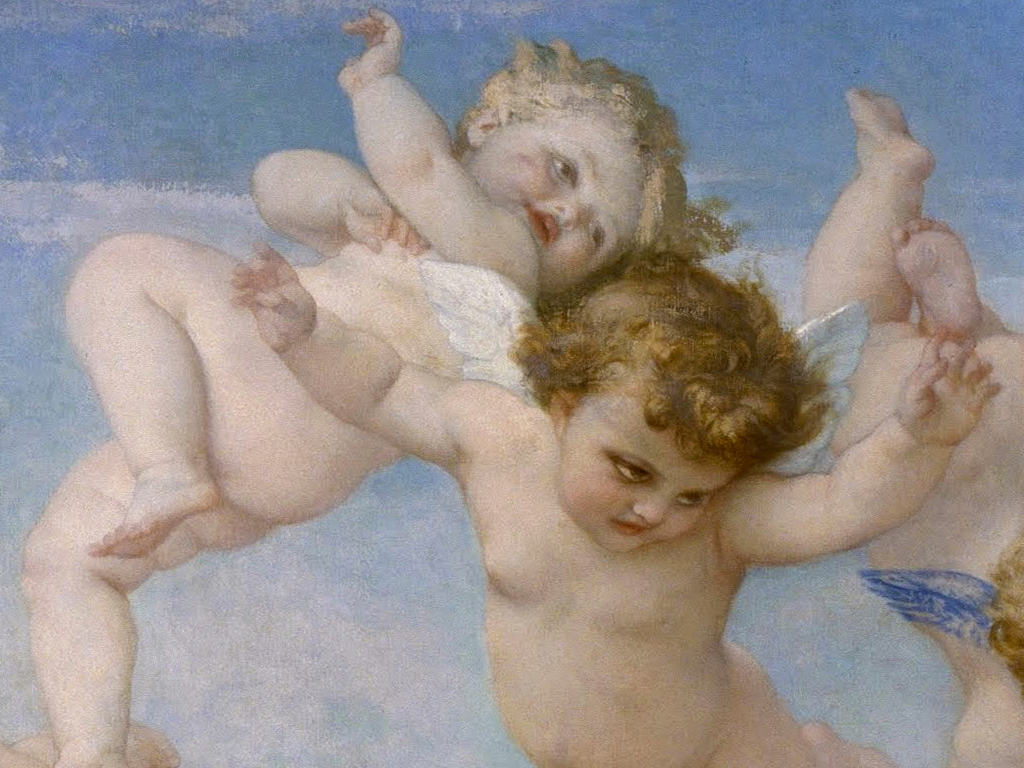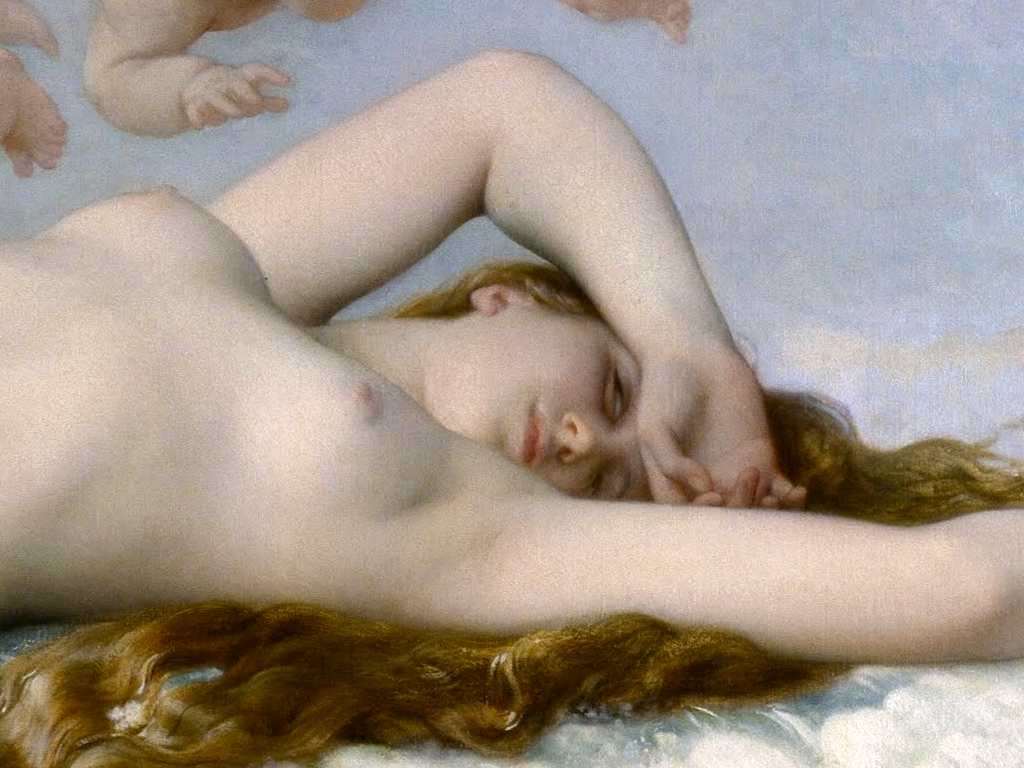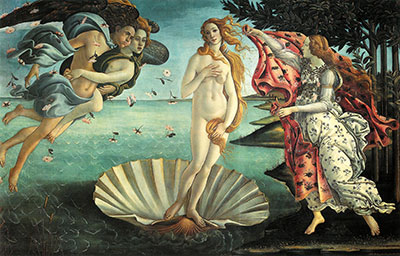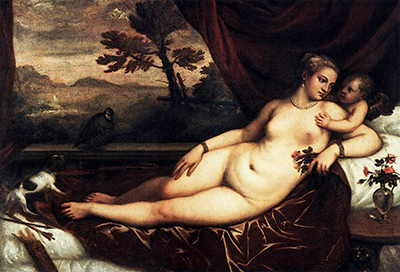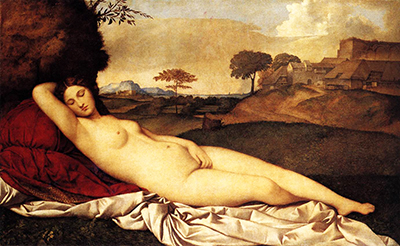The Birth of Venus from 1863 is one of Alexandre Cabanel's most famous paintings. It resides today at the Musée d'Orsay in Paris, where the artist spent much of his working life.
Introduction
Coming, as it did, in 1863, Cabanel would have been around forty years of age at the time that he produced this artwork. He had learnt his craft in Paris through the traditional route of academic teaching, before spending a number of years in Italy where he finetuned his education and technique. He was a fully rounded, confident artist by the time that he painted The Birth of Venus.
The artist learnt much from his main tutor at the Ecole des Beaux-Arts, Picot. That master had already spent decades on similar themes of mythology and religion, encouraging his pupils to continue this legacy. Cabanel mastered figurative art to a level rarely seen before, and his fluid brushstrokes were at their most powerful in these lifesize portraits.
French art was approaching something of a crossroads at this point, thanks to the rise of the Impressionists that would ultimately inspire many new art movements after the turn of the century. Cabanel was very much a part of the old guard, defending traditional artistic values and techniques, even in the face of changing tastes and fashions.
The Birth of Venus has proven to be an inspiring theme for artists across a varity of movements, ranging from the Renaissance up to the Academic Art movement in which Cabanel himself was so prominent. It is the beauty of the female body, combined with elements of nature that perhaps have made this topic quite so suitable, especially for those who were already highly skilled in figurative art and portraiture.
The Birth of Venus is considered by many to be the artist's most famous painting, though others today might dispute that, because of the increased popularity of Fallen Angel. The two artworks have clear similarities, the most obvious being in how the main figure partially covers their face with their arm, which provides a symbolic meaning to each work.
This article examines Alexandre Cabanel's The Birth of Venus in detail, discussing its impact within his career, as well as the controversies that it brought to his work. We also discuss other interpretations of this popular theme within French art, and provide technical information about the piece, such as its size, medium and current location.
Table of Contents
- Introduction
- Background
- Description
- Analysis
- Location
- Size and Medium
- Famous Birth of Venus Paintings
- Large Images
Background
Cabanel's impressive piece was unveiled at the Salon in 1863, and was immediately acquired by the ruling monarch of the time, Napoleon III. It perfectly encapsulated a moment in French art history, conforming to academic structure and teaching, though still able to cause a touch of controversy with some. The artist was at the height of his powers by this stage, as he approached middle age, and would soon be appointed professor of the Ecole des Beaux-Arts. His legacy was also strengthened by the approval of Napoleon III, who now considered him to be one of his favoured artists.
Description
This memorable composition features Venus, the God of love, beauty and desire, reclining on the surface of a wave, whilst a number of playful cupids fly above. Venus lies unclothed in a manner that would excite some, and shock others during the more conservative 19th century. She covers her forehead with an angled arm, whilst retaining a shy look towards the viewer.
The cupids stare directly down at her, symbolising her prominent role within the composition, whilst the background is kept bright but relatively simple. Venus herself is represented by a beautiful, tall young woman with the common look found with most of his models. Her hair hangs loosely, whilst her slim body is perfection itself, or so according to French 19th century tastes.
A closer inspection reveals the cupids are playing music from large shells, with a number of them displaying pretty wings from their backs. It is an upbeat painting, and we have included larger images of it here. Cabanel chose to use particularly large canvases at this point in his career, which enabled him to implement some incredible levels of detail, and in some cases producing life-size figures, with this canvas stretching to over two and a half metres in width.
Analysis
As decribed by a respected art historian below, Cabanel's Birth of Venus was years in the making, taking in elements of the artist's evolution and experimentation as outlined in his previous paintings. For example, we find the same bent arm that would appear in Fallen Angel, and the use of undressed slim models in this manner appears again in many of his other works.
"...The lightest of color used in The Birth of Venus alludes to the lightness and enlightenment of relaxation, amplifying the reclining nude’s placid demeanor and virginity. The contrapposto twist of the figure with the melodramatic swoop of the arm over the face comes directly from his previous paintings Venus herself takes over the entire front of the picture plane. Her hair has been deepened, adding more to her allure and purity..."
Jenna-Marie Newberry
There is a clear influence from the artist's early training under François-Edouard Picot, too. Léda is perhaps the closest example to this composition, though more generally, he would introduce the artist to such topics. He encouraged Cabanel to familiarise himself with classical history and literature. Away from the subject matter, Cabanel relied on his impressive technical skills and the huge canvas found here allowed him to show these off in their full, with considerable detail applied right across the canvas, including on the cherubs playing shells as musical instruments.
The Birth of Venus offered 19th century artists the opportunity of including nudity within their work, but whilst being able to reject accusations of immorality within their work, because of the subject's connection to mythology. Many artists took this opportunity besides Cabanel. Other artists would approach such topics without the same subtlety, however, almost goading the viewer into shock, and they would be more likely to arouse controversy for this reason.
This highly significant work, considered by many to have been Cabanel's finest artwork, has since been exhibited all across the world, travelling as far afield as Germany, Spain, Japan and South Korea. It transferred from Napoleon III's private collection into the national French collection and was displayed at the Louvre prior to arriving at its present location in the 1970s.
Location
Alexandre Cabanel's The Birth of Venus can be found at the Musée d'Orsay in Paris, France. It's original French title was Naissance de Vénus and it arrived at the museum in 1978, having originally been displayed elsewhere in the French capital.
Size and Medium
Depending on how you measure the piece, it ranges from 225 cm to 250 cm wide. Either way, it is a huge artwork, and one of Cabanel's largest. It is around 130-150 cm in height, and therefore follows the standard ratio for a landscape painting. It was produced using oils, as was the preferred method for this artist, throughout his career.
Famous Birth of Venus Paintings
The Birth of Venus was a particularly popular theme within art during the Renaissance and Baroque eras, and continued into later art movements such as Academic Art, as with Cabanel. Several elements remained constant throughout these different interpretations, such as the alluring figure of Venus herself, as well as the inclusion of shells in various ways. Artists would also often fall back on other items that relate to Goddess Venus.
Whilst Cabanel's version is highly regarded within 19th century French art, it cannot claim to be the most famous Birth of Venus painting of all. That prize is awarded to Sandro Botticelli's version from circa 1484–1486. That famous piece may well have influenced Cabanel's own work, and he did spend a number of years living in Italy, studying Renaissance paintings and sculptures from around the same period of Botticelli.
Venus Rising from the Sea (Venus Anadyomene) by Titian, Venus Rising from the Sea by James McNeill Whistler are two more notable examples, and Venus herself appears on many other occasions in other narratives. Rokeby Venus by Diego Velazquez, Venus of Urbino by Titian, Sleeping Venus by Giorgione and Venus Verticordia by Dante Gabriel Rossetti are just a few of the best examples of this.
Large Images
This huge canvas is around two and a half metres wide, making it impossible for a small image to really display the beauty of this work. As such, we have included larger images of The Birth of Venus below, both of the work in its entirety, plus also some details of speific parts of the painting. Hopefully this provides some understanding of the work completed by Cabanel on this piece, for those unable to view it in person at the Musée d'Orsay in Paris.



